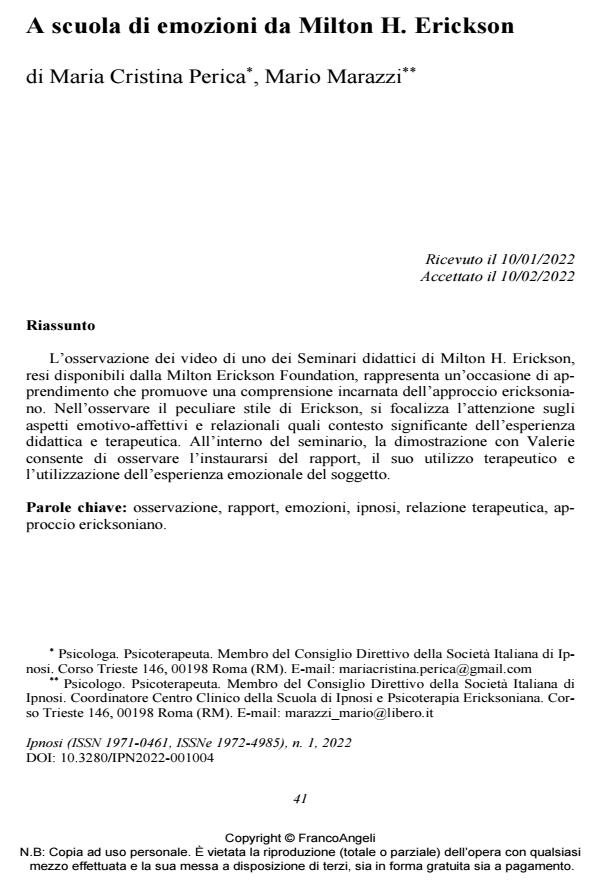Learning emotions from Milton H. Erickson
Journal title IPNOSI
Author/s Maria Cristina Perica, Mario Marazzi
Publishing Year 2022 Issue 2022/1
Language Italian Pages 14 P. 41-54 File size 181 KB
DOI 10.3280/IPN2022-001004
DOI is like a bar code for intellectual property: to have more infomation
click here
Below, you can see the article first page
If you want to buy this article in PDF format, you can do it, following the instructions to buy download credits

FrancoAngeli is member of Publishers International Linking Association, Inc (PILA), a not-for-profit association which run the CrossRef service enabling links to and from online scholarly content.
Watching videos from one of Milton H. Erickson’s teaching seminars, released by the Milton Erickson Foundation, represents a learning opportunity that fosters an embodied understanding of the Ericksonian approach. Observing Erickson’s unique style, the authors focus on the emotional-affective and relational aspects as a significant context of the teaching and therapeutic experience. Within the seminar, the demonstration with Valerie allows observing the establishment of rapport, its therapeutic application and the utilization of the subject’s emotional experience.
Keywords: Observation, rapport, emotions, hypnosis, therapeutic relationship, ericksonian approach
- Caillé P., Rey Y. (2005). Gli oggetti fluttuanti. Metodi di interviste sistematiche. Roma: Armando.
- De Benedittis G. (2006). Alla ricerca del sentiero che ha un cuore: omaggio a Milton H. Erickson (1900-1980). Ipnosi, 1: 5-14. DOI: 10.1400/62857
- Di Dio C., Gallese V. (2022). Moving Toward Emotions in the Aesthetic Experience. In Chatterjee A., Cardillo E.R., ed., Beauty and Art: essays bringing neuroaesthetics into focus. Oxford University Press (ebook), cap. 5, pp. 88-91.
- Ducci G. (2000). La relazione terapeutica in ipnosi. In Loriedo C., Santilli W., a cura di, La relazione terapeutica. Milano: Franco Angeli.
- Gallese V., Guerra M. (2015). Lo schermo empatico. Cinema e Neuroscienze. Milano: Cortina.
- Loriedo C., Perica M.C. (2020). Rapport: il vantaggio della relazione ipnotica nel lavoro clinico. In: Mammini C., Mazzone E., Paganelli M., a cura di, Il rapport: una relazione speciale che cura. Responsività, reciprocità e sincronismo nella psicoterapia naturalistica ericksoniana. Milano: Franco Angeli.
- Shore A.N. (2021). The Interpersonal Neurobiology of Intersubjectivity. Frontiers in Psychology, 12: 616-648.
- Yalom Y. (2002). Il dono della terapia. Milano: Neri Pozza Editore.
- Zeig J.K. (1983). A scuola di ipnosi. Torino: Bollati Boringhieri.
- Zeig J.K. (1985). Erickson. Un’introduzione all’uomo e alla sua opera. Roma: Astrolabio Editore.
- Zeig J.K., Geary B. (2000). The letters of Milton Erickson. Phoenix: Zeig, Tucker & Theisen.
- Zeig J.K., Tanev K.S. (2020). Marital Hypnotherapy: A Session with Milton Erickson with Commentary. International Journal of Clinical and Experimental Hypnosis, 68(3): 263-288. DOI: 10.1080/00207144.2020.1762493
- The Prestige: tra dedizione e ossessione per la tecnica Luca Bidogia, Antonio Piro, in IPNOSI 2/2025 pp.51
DOI: 10.3280/IPN2024-002005
Maria Cristina Perica, Mario Marazzi, A scuola di emozioni da Milton H. Erickson in "IPNOSI" 1/2022, pp 41-54, DOI: 10.3280/IPN2022-001004